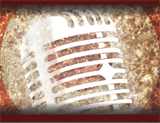“Hi, I’m Johnny Cash . . .” It has been 40 years since Johnny Cash walked onto the stage in the Folsom Prison cafeteria and said these words, kicking off his historic and groundbreaking concert. There is a great deal of myth surrounding Johnny Cash, much of it promoted by The Man In Black himself. One undeniable fact is that Cash’s live album, At Folsom Prison, is one  of the great live recordings of all time. The record was, in fact, added to the Library of Congress’s National Recording Registry in 2003. The record was also recorded 40 years ago, on January 13, 1968. To my mind, At Folsom is the apex of Johnny Cash’s early career, the way the American Recordings he made with Rick Ruben represent the end of his career.
of the great live recordings of all time. The record was, in fact, added to the Library of Congress’s National Recording Registry in 2003. The record was also recorded 40 years ago, on January 13, 1968. To my mind, At Folsom is the apex of Johnny Cash’s early career, the way the American Recordings he made with Rick Ruben represent the end of his career.
If you have seen the film, Walk the Line, you can get a bit of a sense of what it must have been like to record at Folsom Prison. Folsom was the last stop for hardened criminals in California. However, the film does take a few liberties. For instance, Cash was not, as the movie would lead you to believe, totally free of drugs at the time of the concert. He was certainly not incapacitated by drugs the way he once was. But drug free? No. This is well documented in the excellent book Johnny Cash at Folsom Prison: The Making of a Masterpiece by Michael Streissguth. Streissguth has also written a great biography of Johnny Cash that takes an honest look at Cash’s life, trying to see clearly through the myth. In addition, while Cash does comment on the prison’s water with a pretty colorful description, he does not in address the warden or smash the glass of water on the stage as the film depicts.
But why record a concert in a prison? For Johnny Cash, there were a few reasons. He certainly had an emotional connection to the folks in prison. He once met with Richard Nixon to discuss prison reform. In his autobiography he described how he tried to represent “voices that were ignored or even suppressed in the entertainment media, not to mention the political and educational establishments.” There was also, certainly, a connection to Cash’s religious beliefs involved in this. He was very clear to point out, however, that he wasn’t a Christian artist. He was, “an artist who is a Christian.”
Beyond the aforementioned reasons, Cash also, needed a hit record. His years of drug abuse had taken its toll on both the publics’ view of him and his finances. Clive Davis who was the head of CBS Records, Cash’s label at the time, thought the idea of recording a concert at Folsom—in the prison cafeteria, to hardened inmates—was a terrible idea. He thought it wouldn’t sell. As Cash wrote in his liners notes, he knew that a “prison would be the place to record an album live.” And he was right. Not only did it sell, it sold a lot. It went Gold and it was his best-selling album up to that point. And it sold at a time when, even talking into account Cash’s relationship with Bob Dylan, his music was not in fashion. This was 1968: a year before Woodstock, the Vietnam War was raging; campus protests were prevalent. However, concern and compassion for prisoners was not a part of the philosophy of that time.
But in the end what makes this recording so great is the music. There is immediacy and an edge to At Folsom Prison that draws the listener into the experience. Two songs among all of the great tracks highlight this album: the opener, “Folson Prison Blues,” and “Greystone Chapel.” “Greystone Chapel” was written by an inmate at Folsom and Johnny Cash just learned the song the day before the concert. There is also purity to the recording. With the notable exception of the dubbing of a cheer from an inmate in the audience when Cash sang his famous line, “I shot a man in Reno, just to watch him die,” the record really captures the experience and sound of the concert—of a performer climbing his way back to the top and an audience with nothing left to loose.
skip to main |
skip to sidebar




0 comments:
Post a Comment